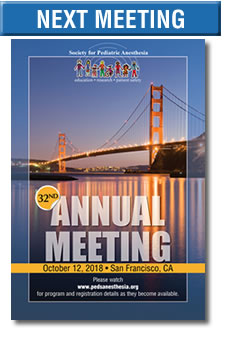Pediatric Anesthesiology 2018 Reviews
Friday Session IV
Pediatric Surgery in Low and Middle Income Countries: A surgeon's perspective
Reviewed by Toyin Olutoye MD., M.Sc.
Texas Children’s Hospital
Baylor College of medicine
Houston, TX
Dr. Doruk Ozgediz (Yale University, New Haven, CT) presented this talk which centered on:
- Global burden of disease and disparities for pediatric surgery in low middle income countries. (LMIC’s)
- Outline of models of effective global surgery engagement
- Discussion of current and future areas of collaboration between surgery and anesthesia providers in LMIC’s
Dr. Ozgediz has worked off and on in Uganda for the past 15 years and started his presentation with pictures of children with extensive disease such as massive sacrococcygeal teratomas and severe abdominal distension due to untreated Hirschsprung’s disease. He mentioned how the severe abdominal distension these children experience presents a huge anesthetic challenge for the anesthesia providers in developing countries. He also described how a colostomy (necessary in the initial surgical management of Hirschsprung’s disease), results in marked socio-economic burden as children with a colostomy miss a lot of school days and there is also a several months wait before surgery can be performed.
- Global burden of disease and disparities for pediatric surgery in low middle income countries (LMIC’s)
Thirty percent of global burden of disease is surgically treatable but the low middle income countries, (LMIC’s) suffer from a lack of adequate surgeons. There is one surgeon per 100,000 children in LMIC’s with surgical mortality for even elective cases being twice as high as that of high income countries. Mortality in these countries is primarily due to typhoid intestinal perforation and intussusception. - Outline of models of effective global surgery engagement
The Global Partners in Anesthesia & Surgery (GPAS) was created secondary to difficulty in funding and it has helped attract anesthesia and surgery providers as well as global scholars to low middle income countries. This group has also focused on training lay responders to respond to emergency situations and establish airway control and hemorrhage control prior to patients arriving in the hospital. This group has brought together mission groups and societies to join efforts. - Discussion of current and future areas of collaboration between surgery and anesthesia providers in LMIC’s
The Global Initiative for Children Surgery (GICS) is a group that also aims to bring all global initiatives revolving around children’s surgery together. In addition, it outlines guidelines for children’s surgical care from the community level all the way to tertiary care.
He also mentioned that that a recent American Pediatric Surgery Association survey revealed that approximately 50% of pediatric surgeons are engaged in global surgery. Lastly, he encouraged a development of guidelines for short term missions by the APSA, SPA and SPA society and its SPACIES committee (SPA committee on International Education and Services).






